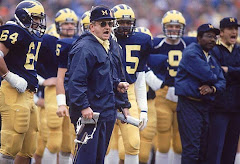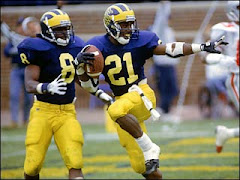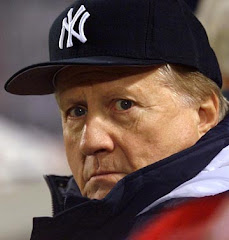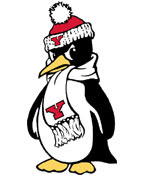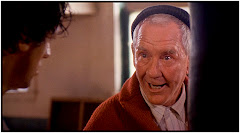 The sports journalism field lost a true legend on Saturday with the death of Jim McKay...they following is a story about McKay which appeared on The New York Times website on Saturday, June 7, 2008
The sports journalism field lost a true legend on Saturday with the death of Jim McKay...they following is a story about McKay which appeared on The New York Times website on Saturday, June 7, 2008Jim McKay, Pioneer Sports Broadcaster, Dies at 86
By FRANK LITSKY and RICHARD SANDOMIR
Jim McKay, the genial ABC Sports broadcaster whose calm voice and trustworthy demeanor were synonymous with the network’s Olympic broadcasts and the celebrated sports anthology series “Wide World of Sports,” died Saturday at his country estate in Monkton, Md. He was 86.
The death was confirmed by Leslie Anne Wade, a spokeswoman for CBS Sports, where Mr. McKay’s son, Sean McManus, is the president.
Mr. McManus said his father, who hosted and commented on Triple Crown races for ABC, might have had only one regret in his life: missing Big Brown’s chance on Saturday to be the first winner of the Triple Crown since 1978.
Mr. McKay was a hype-averse optimist and poetic storyteller who left analysis and brickbats to co-workers like Dick Button, Peggy Fleming, Donna de Varona, Jackie Stewart and Bill Hartack.
Emotion occasionally slipped through objectivity. After an American athlete won a gold medal in the 1984 Summer Olympics in Los Angeles, Mr. McKay said: “If I said I was an objective reporter, I’d be lying through my teeth. I think when an American wins, you’re excited. And why not?”
No matter. As Peter Alfano wrote in The New York Times during those Olympics, television allowed Mr. McKay “to play Uncle Sam for two weeks.”
Mr. McKay’s sincerity came through. Bob Costas of NBC Sports, a younger-generation sportscaster, once said: “Jim McKay had a very important quality. You never felt what he expressed wasn’t genuine. You never felt his reaction was, ‘What’s called for here is a tear.’ You never had a sense that he professed to be moved and when they went to a commercial he blew his nose.”
His professionalism and sensitivity melded in 1972. During the Munich Olympics, as he left the hotel sauna and was about to go into the swimming pool on his only day off, he received word that Arab terrorists had invaded the Israeli living quarters in the Olympic Village. Mr. McKay hurried to the studio, and for 16 consecutive hours he anchored ABC’s extraordinary news coverage, with field reporting from Peter Jennings, Howard Cosell and others.
The episode ended with the killing of 11 Israeli athletes, coaches and trainers. When that word reached Mr. McKay, he said he thought that he would be the person who told the family of David Berger, an Israeli-born weight lifter whose family lived in Shaker Heights, Ohio, “if their son was alive or dead.”
He looked at the lens and said, “They’re all gone.”
When ABC finally signed off, Mr. McKay, physically and emotionally spent, returned to his hotel room. Only then did he realize he had been wearing a wet swimsuit beneath his trousers.
The next day, Mr. McKay received this cable from an old CBS colleague: “Dear Jim, today you honored yourself, your network and your industry. Walter Cronkite.” Mr. McKay’s work at Munich won him an Emmy Award for news coverage, the first for a sportscaster, and the George Polk Award. Through the years, he won 12 more Emmys.
Mr. McKay was born James Kenneth McManus — the name he used on his passport and for hotel reservations — on Sept. 24, 1921, in Philadelphia. He moved at age 13 to Baltimore, where in 1943 he received a bachelor’s degree from Loyola College. He served in the Navy from 1943 to 1946, including a period in which he captained a minesweeper escorting convoys from Trinidad to Brazil.
In 1946 and 1947, he was a police reporter for The Baltimore Evening Sun before being shifted to the newspaper’s new television station as a broadcaster, writer and producer. In 1950, when he moved to CBS in New York to host a local daily 90-minute variety show, he was told that his new name, at least for TV, would be Jim McKay, to suit the title, “The Real McKay.” During his debut, Mr. McKay sang “It Had to Be You.”
The next decade brought more television stints at WCBS-TV and the CBS network as a weatherman, a public-affairs moderator, a game show host and a sportscaster. He covered the Masters golf tournament, did play-by-play of Ivy League football games and provided sports reports on CBS’s answer to NBC’s “Today,” the “Morning Show,” which was hosted by Mr. Cronkite.
Mr. McKay was designated to host CBS’s broadcast of the 1960 Winter Olympics from Squaw Valley, Calif., but he had a nervous breakdown and Mr. Cronkite took over. At the Summer Games that year in Rome, Mr. McKay began his run as the TV personality most intimately identified with the Olympics until the late 1980s. He covered 10 Olympics for ABC, and he worked on his last Olympics for NBC, in 2002. His connection to the Olympics is so strong that it seems he was the prime-time host more than he really was.
Before ABC revolutionized Olympic broadcasting and satellites transmitted sports events instantly, CBS had footage shipped from the Rome Games daily to New York’s Idlewild Airport (now John F. Kennedy International), where a remote broadcast unit put the footage on the air while Mr. McKay narrated from a studio erected at Grand Central Terminal.
“The tapes came in frozen one night,” he said in 2002. “The producer and I held the tapes against our bodies to warm them.”
In 1961, Roone Arledge, the executive producer of ABC Sports, needed a host for “Wide World.” One of his producers suggested “Burrhead,” a reference to Mr. McKay’s crew cut. Mr. Arledge called Mr. McKay at the noisy press room at Augusta National Golf Club during the Masters, which was his last assignment for CBS. In his autobiography, “The Real McKay,” Mr. McKay said Mr. Arledge promised him only 20 weeks as the host of a summer replacement series that would cover “a number of sports not normally seen on TV.”
It lasted for 37 years, with Mr. McKay the host for at least 25 of them, and became the most honored anthology series. As the adventurous host, he traveled more than five million miles to cover boxing, skiing, soccer, gymnastics, track and field, figure skating, rodeo, barrel jumping, horse racing, cycling, demolition derby and Eiffel Tower climbing. A promoter once demanded $100,000 for the rights to cliff diving in Acapulco, but Mr. McKay moved in and offered the divers $10 each. They accepted.
He and Mr. Arledge were believed to have collaborated on the introduction to “Wide World,” which Mr. McKay narrated over a montage of sports scenes. The enduring script included the phrase “the thrill of victory,” followed by a melodramatic pause, ominous music and the words “the agony of defeat.”
Mr. McKay is yet another of ABC Sports’s early giants to die: Mr. Arledge is gone, as are Mr. Cosell and Chris Schenkel.
“Because of the profession I’m in, not a day goes by when someone doesn’t stop me and say, ‘We think of him all the time’ and ‘We admire him,’ ” Mr. McManus said Saturday. “That tells you a lot about the kind of man he was.”
In recent years, Mr. McKay owned racehorses and lived in a 19th-century farmhouse in the horse country of Monkton, north of Baltimore. His most recent work included commentary from the Winter Games in Salt Lake City and writing and narrating a documentary about himself for HBO.
Besides Mr. McManus, he is survived by his wife, Margaret Dempsey, a former columnist for The Baltimore Evening Sun; a daughter, Mary Guba, of Sparks, Md.; and three grandchildren.
Except for his globetrotting, Mr. McKay and his wife were nearly inseparable during a nearly 60-year marriage. In sedentary semiretirement, he said in 2002, he read to her from newspapers and recalled a recent illness that did not allow her to move her arms or legs.
“When she said, ‘I’m dying,’ it was the worst moment in my life,” he said, with fear and love in his familiar voice.









